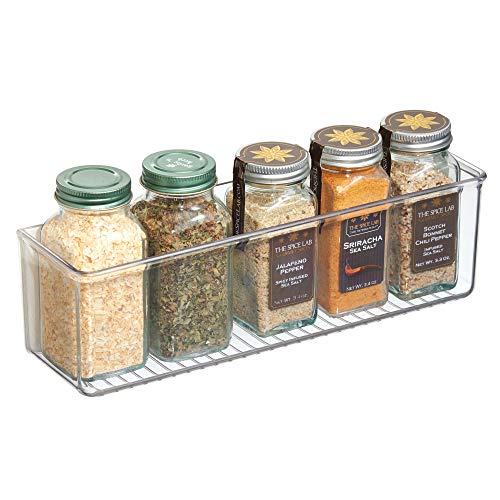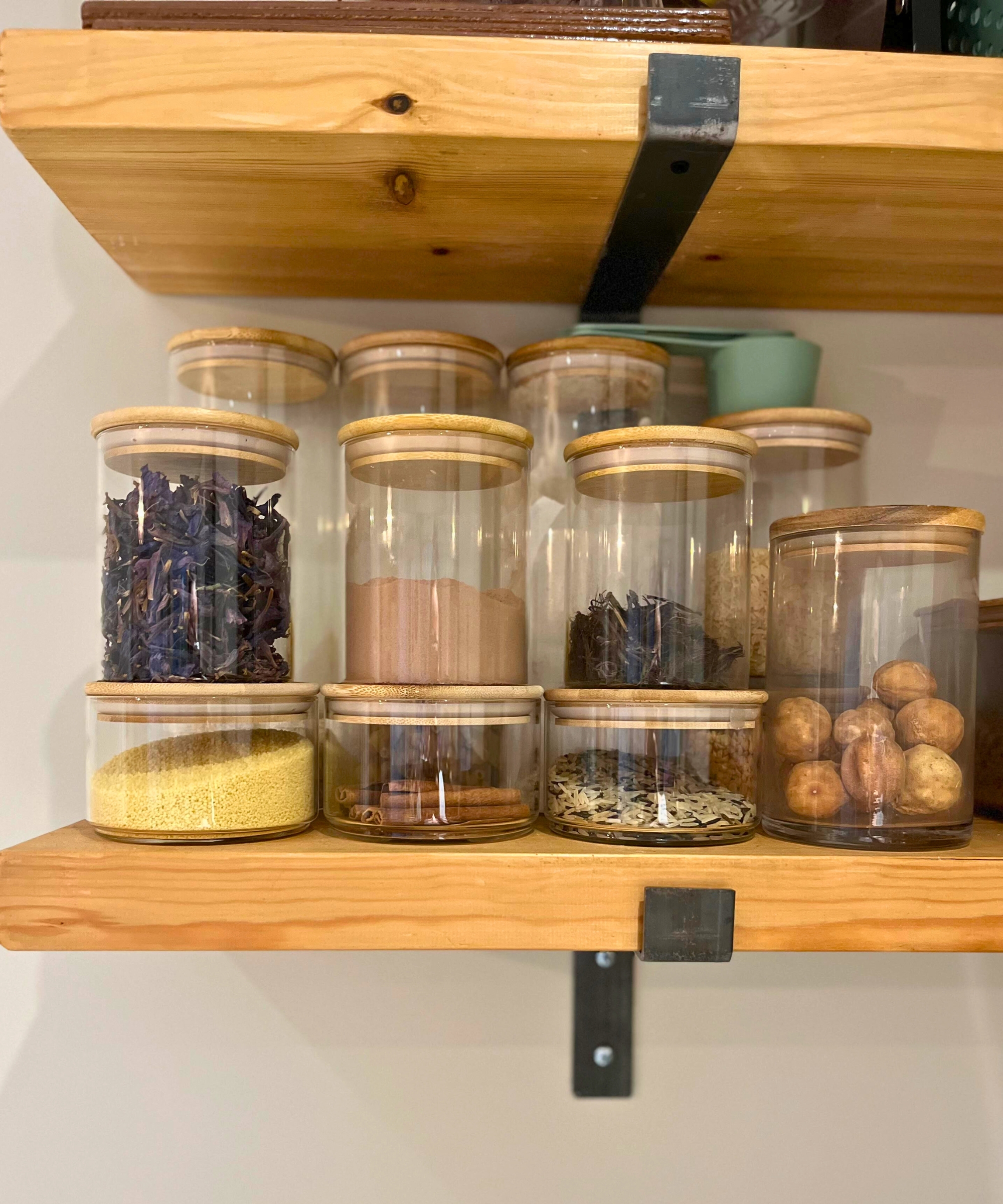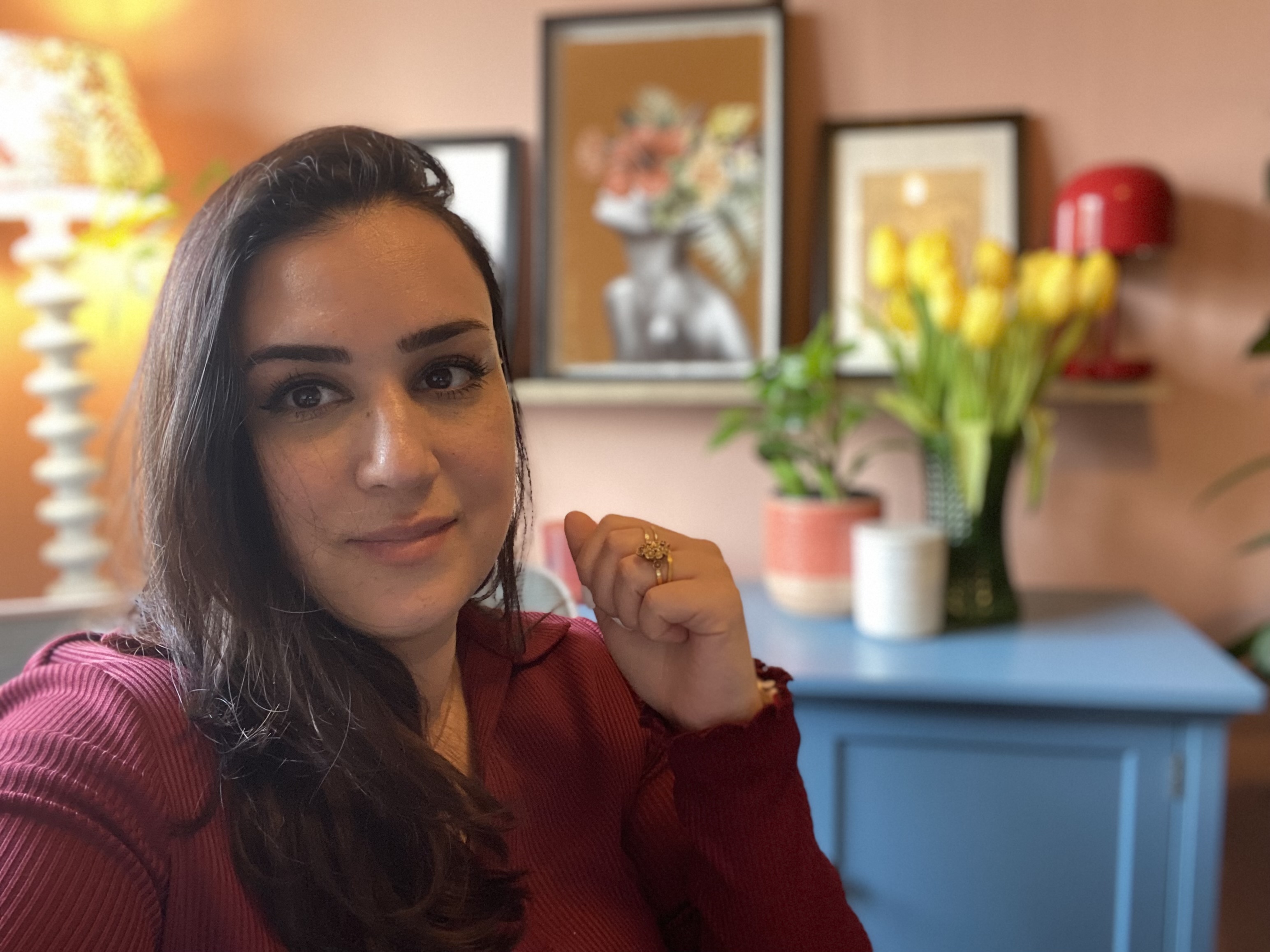
- 1. Streamline your spices
- 2. Group in clear storage bins
- 3. Use snap or clipper spice racks
- 4. Use drawer organizers
- 5. Decant into uniform jars
- 6. Label your jars
- 7. Position near the cook zone
- 8. Utilize awkward spaces
- 9. Use carousels and tiered storage
- 10. Inside pantry doors
- 11. Magnetic racks
- 12. Counter top spice storage
- How do you organize spices in a drawer?
In order to cook our favorite meals, most of us will use an abundance of herbs and spices. But how are yours organized, and is that storage system still serving your needs?
If your spice collection is spread out in various areas of your kitchen, you have duplicates of of the same item, are contending with out of date products or simply don't really know what you have in your cabinets, this may be the perfect time to organize your spices and delve into a storage system that really works for you.
Our professional organizers and food loving homes editor reveal the many ways you can streamline, organize and store your herbs and spices to help you get back to hassle-free cooking. Organizing a kitchen area as vital as this one doesn't have to be arduous no matter how small or large your spice collection.
The best ways to organize your spices
Along with good kitchen storage ideas, a methodical system for organizing spices will make them accessible to you when you need them, and improve function in your kitchen when cooking.
The first step is letting go of any feelings of shame, guilt or shock when you pull out every herb and spice pot, jar, and packet you have during your stock take to asses what you're going to keep or bin.
‘I’ve found spices dating back to 1995 in one of my customer’s cupboards so don’t worry – everyone has something out of date,’ says professional home organizer Rachel Burditt, also known on Instagram as The Declutter Darling.
1. Streamline your spices

Before you start organizing your herbs and spices, pull out what you have and consolidate your collection. A useful decluttering tip is to get rid of duplicates and any expired items. While most dry herbs, spices and seasoning mixes don’t really go bad, over time, you might find they lose their potent aroma, or begin clumping from when the jar or lid has been hit with steam mid-cook.
Design expertise in your inbox – from inspiring decorating ideas and beautiful celebrity homes to practical gardening advice and shopping round-ups.
It's also useful to get rid of anything you haven't used in the last six to 12 months. It's probably not going to be used moving forward and will free up vital space.
To organize yours:
- Group together: Keep your most-used spices in prime position, separate from the rest of your spice collection. You can use a portable spice caddy or carousel-style organizer. That way, you can move them around easily as you’re cooking.
- Alphabetize: This is a good one if you have a large collection so you can quickly find what you need, or if you're new to meal prep and experimenting your way through cooking sessions. 'This way you can go straight to what you need, particularly if there’s more than one cook in the house’, adds Andra DelMonico, lead interior designer at Trendey.
- Categorize by type: This is about what makes the most sense to you and how you use herbs and spices when cooking. You you might categorize by cuisine, or type (baking, or aromatics for example). This works for some people but you might find there is some crossover.
2. Group in clear storage bins

I grew up in a Persian household where spices and herbs were the lifeblood of our daily cuisine. I took this love of aromatics and spices into my own home later, and for many years was a BBC Good Food columnist, exploring and writing about all sorts of foods, cuisines and recipes from around the world. I have a vast collection of herbs and spices and use clear storage bins inside my dedicated herbs cabinet, right next to my stove for ease of access and use mid-cook.
I have categorize mine by grouping my jars by whether they are single spices, single herbs, spice mixes, and refills, and popping each set of these jars in clear containers with labels on. You can use a best selling label maker, or a pack of easy-peel oil resistant labels both available at Amazon. The labeling helps me identify what I need quickly, but also means my husband can easily stick with my spice organization system when he's cooking with minimal effort. Keeping things easy for your household is the keep to maintaining this space moving forwards.
In my kitchen, pictured above, I also added an additional shelf in the middle to make use of dead vertical space as two shelves were not enough for the volume of herbs and spices I needed to organize. I store the tall oil bottles on the lowest shelf and pack the others with shorter jars and canisters.

This set of clear containers is very similar to mine and you can opt to buy them in packs of 4, 6, 8, 10, 12 and five different sizes to make the absolute most out of your space. Measure up your cabinet or the area you're planning on storing your herbs and spices and see the best size for you before purchasing to avoid dead space.
3. Use snap or clipper spice racks

Save time and boost efficiency by creating an area for a smaller group of your most-used spices and storing them in prime position, separately from the rest of your collection. Place them together on a snap spice rack such as the one pictured in my kitchen above. You can purchase a set of six spice gripper click strips from Amazon.
They're cheap, drill-free to install and work great without cluttering up your counter with the things you need the most. I keep these few items in the kitchen cabinet to my left, next to the stove for easy access.

A more aesthetic option that you can grab in four different sizes to suit your space and jars.

You can opt for an iron one like this to keep your most used herbs and spices on a nearby wall, inside or on the side of a cabinet near your cooking zone.

The brand is known for its durable, easy to use and damage-free removal so this is great if you want to retain with certainty the integrity of the surface you're placing it on.
4. Use drawer organizers

If you keep your herbs and spices in a drawer next to, or under your built-in stove top, use drawer organizers such as the YouCopia 10 inch drawer organizer or an expandable drawer rack, both from The Container Store, to help you visualize them easily whilst laying them at an angle, and keeping them from rolling around.
Using a clever spice organizer such as this also allows you to store other kitchen utensils in the same handy space without everything getting tangled or jumbled up together.
‘A bespoke drawer inlay allows you to lay spice jars with their labels easy to read at a glance, so you can clearly see what you have,’ says Tom Howley, design director at Tom Howley. ‘Not only is this more efficient when cooking, but storing them in a cool, dark drawer can extend the life and flavor of your spices.
5. Decant into uniform jars

Spice packaging can come in many different shapes and sizes making them a bit trickier to store in a uniform manner and can look somewhat chaotic. If you have open shelving, this can add to visual clutter.
If like me you buy a large volume of herbs and spices or use them to refill existing jars, consider investing in a uniform set to streamline the way yours look, such as a set of glass airtight hinge-lidded jars from Amazon. Make sure they’ve got rubber seals to maintain freshness and that you can comfortably fit a teaspoon inside, like mine below, available at Walmart with bamboo lids.
‘It’s a great way of keeping your eye on stock levels as well as maintaining a uniform and stylish storage space’, says Melissa Klink, head of design at Harvey Jones.
If you’re storing your spices, herbs or condiments on display in open shelving as pictured below in my kitchen, bear in mind that direct sunlight can affect the quality of your spices over time, so choose your jars and placement wisely. I have installed my open shelving at the far end of my kitchen which is away from the moisture and steam of my cooker, but also does not get hit with direct sunlight.

Some of the extra storage I have on my open shelves including cinnamon, valerium root, dried limes and dried cornflower
6. Label your jars
Spices can look similar, so efficient labeling is essential to ensure you avoid any cooking mishaps. How you’re planning to store your spices will affect how best to do it.
‘If you’re storing spice jars upright in a drawer, place name labels on the lid,’ advises Ann Lightfoot, co-founder of Done & Done Home. ‘If storing on shelves or laid flat, position label the side of the bottle so they can be seen at a glance. Remember to write the expiration date on the bottom of the jar when you decant.’
If your spices are out on show, Al Bruce, founder of Olive & Barr suggests ‘giving glass containers an upgrade with customized labels – this will help to streamline the whole look while adding an extra element of style’.

Easy to use with up to 15 memory slots for easy reprints, this handheld label maker is perfect for organizing and labeling your herb and spice jars and canister or other labeling jobs around the home. It's inkless, using thermal technology to print your words and the QWERTY keyboard makes it double-y easy to use.
7. Position near the cook zone

Organizing a kitchen by activity makes it easier to navigate and when this is missing, it's one of the first things professional chefs notice in badly organized kitchens. Whether yours herbs and spices are stored in drawers, cabinets, on counters, shelving or hanging up on wall-mounted racks, locate yours as near to the stove and food prep areas as possible.
Not only will this make it easier to access what you need in the middle of preparing or cooking, it reduce the risk of cross contamination, especially when marinating meat or fish.
If your kitchen layout doesn’t allow for this, consider keeping your most-used spices in a freestanding kitchen organizer or an elevated carousel. You can better organize kitchen countertops so your collection can be moved nearer to where you cook.
Keep surplus supplies out of the way in a pantry of cabinet so they do not get opened and sealed instead of the main jar as this can make them lose their aroma quicker.
8. Utilize awkward spaces

The beauty of spice jars is their petite proportions, meaning they can fit nicely into spaces that might otherwise go unused. Bespoke storage can utilize these spaces to their best potential.
‘Pull-out or pull-down storage makes for a smooth cooking experience, providing easy access to ingredients right where you need them,’ says Graeme Smith, head of retail and design at Life Kitchens. ‘Many are available in a variety of sizes, with a range of boxes, trays and other inserts that will hold bottles, plates, glasses and more, perfect for positioning beside the hob for quick access to your herbs and spices.’
Consider having this space built in to your kitchen design or remodel. You can also buy tiered slide out spice storage shelves to place inside existing cabinets.

This needs a little bit of installation but it's an easy system involving just two screws and you don't need to measure them. Choose from a wood or chrome look, and multiple tiers and dimension options. There is sure to be one configuration that fits your awkward space.
9. Use carousels and tiered storage
If bespoke cabinet adaptations or full kitchen remodels aren’t on your home agenda any time soon, better organize your kitchen cabinets with some clever spice storage options:
- Tiered pantry organizers: These create staggered shelves, elevating items at the back of cabinets so you can see what you’ve got more clearly and reducing the chances of forgetting a whole row of items.
- Risers: These help you position items for better extra visibility. You can then use the cubby hole underneath to store refills or other dried goods.
- Non-slip liners: also stop jars from tipping over and catch any mess, especially with spices like turmeric or saffron which are pigment rich and hard to shift stains of.
- Use Lazy Susans: Spinning tiered storage is brilliant for packing a lot into one space without losing visibility, and negating the need to pull out everything in front to get to what is at the back. 'If you have the space, home organizer Emma George of Declutter with Emma recommends positioning a lazy Susan inside a cabinet. She says, ‘They keep jars in place and rotate so you can easily access what you need without having to rummage around and knock things over,’ she says. These can also be useful when you’re organizing deep pantry shelves so your grouped spices stay together.

This roll of oil-proof, slip-resistant and washable shelf liner will come in hand all over the home from inside your cabinets, under shoes, in the fridge and drawers.

This tiered spice organizer is made from stainless steel and therefore both hardy and easy to clean. The raised edge around each tier will stop your jars tumbling off when you spin.
10. Inside pantry doors

Professional organizers will tell your using up any dead space you have is a brilliant way to increase storage without adding freestanding units that take up floor or counter space.
You can utilize the inside of your cabinet and pantry doors to keep your spices tucked away tidily and still easy to locate. A no-drill door hanging spice rack such as the Rebrilliant Nwamaka from Wayfair provides single-row storage for herbs, spices, oils, condiments and other every day ingredients, ensuring they won’t end up obscured by other items.
Shelves of varying heights enable you to arrange like you would when organizing a pantry; heavier, less-used items stored at bottom, more frequently used items nearer the top, ideally at eye-level. Just be sure to check there is enough clearance from the edge of your pantry shelves to the inside of the door.
While a bespoke design is hard to beat, store-bought varieties work well, too. Wooden ones will clank less when you open the door, such as the wooden tall door mount unit from Amazon, whereas mettle in-door racks such as the space-saving Prep & Savour wire shelving from Wayfair are easier to clean
11. Magnetic racks

This is particularly handy if you have a metal wall feature or fridge unit near your cooking space. Simple mount and stack with your herbs and spices for easy access you can remove, reposition, or re-organize anytime.
12. Counter top spice storage
There are many nice-looking and functional options for organizing and storing your herbs and spices on your countertop. This aid easy access, frees up cabinet space and can be a nice aesthetic addition to your space, especially if the rest of your counters are relatively free from utensils, small appliances and other open storage options.
I had a 20 jar spinning unit similar to this one available at Amazon, and I moved to cabinet storage options when my collection grew too large. It's a great starter kit or nice for a refresh.
FAQs
How do you organize spices in a drawer?
How you organize your spices is primarily dictated by the depth of your drawer. For deep drawers, your spices can be stored standing up. Order alphabetically and use vertical separators to keep them from falling over, or group them by category and place them into clear containers, trays or baskets. Make sure you clearly label the lid for easy access.
Laying spices flat on their sides is a good option for slim drawers and offers the added benefit of being able to see when they’re about to run out, so you can restock in plenty of time. Use bespoke inlays to keep them from rolling around and position alphabetically with the label facing outwards so you can locate what you need at a quick glance.
Now your spices are in ship shape, delve into our kitchen decluttering checklist to turbocharge the rest of your room's storage.

Punteha was editor of Real Homes before joining Homes and Gardens. She has written and edited wellbeing, lifestyle, and consumer pieces for the national press for 17 years, working across print and digital newspapers and magazines. She’s a Sunday Times bestselling ghostwriter, former BBC Good Food columnist and founding editor of independent magazine, lacunavoices.com. Punteha loves keeping her home clean, has tested and reviewed the latest robot vacuums and video doorbells, enjoys cooking, DIY, decluttering and spending weekends improving her newly-built home. Punteha is disabled and in chronic pain, so small, paced projects that bring big impact and make her household run smoothly are her focus.
- Tara KingContributing Editor




